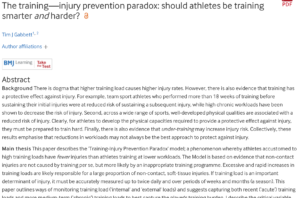by Mitch Hauschildt, MA, ATC, CSCS
Recently I came across an article that discussed whether or not we should train smarter or harder to prevent injuries. I think that most people on the clinical side of the sports medicine profession would say that we definitely have to train smarter. The goal with smarter training is to pick the perfect movements, sets, reps and loads to find a sweet spot of training that gives you just enough stimulation to make an impact in movement quality, but no more than the minimal effective dose. I think that there is a lot to be said for this approach.
I’m guessing that those who are on the performance side of the sports medicine profession would say that we have to train harder. Their argument is that being fit, strong, stable and well trained will make up for a lot of movement deficiencies when you consider injury risk.
In my opinion, both are true and the best in the business combine both worlds. I’m lucky in that I’ve had the privilege over the years of working as a division 1 strength coach. I’ve seen what it takes to build great athletes who don’t break down physically or mentally under the stress of a big time sporting event in front of thousands of people in person and on TV.
I’ve also had the advantage of working on the rehab side of the profession where I have had to fix the results of crazy training and ignored poor movements. It always saddens me to have to fix people after the fact when I know that many things can be prevented.
Tim Gabbett makes an excellent case in this article that we need to train smarter AND harder. His focus is on general fitness in the sports of soccer, rugby and cricket, but the principles can and should be applied to all sports and athletes. He makes a number of good points, but here are a few things that stood out to me:
- Team sports athletes who performed greater than 18 weeks of training before sustaining their initial injuries were at reduced risk of sustaining a subsequent injury. This tells us that training is very important for dealing with injuries.
- There is evidence that both overtraining and under training are risk factors for injury.
- Across a wide range of sports, well developed physical qualities are associated with a reduced risk of injury. This speaks to the fact that great athletes don’t get injured as often.
- Both internal and external training loads affect injury risk.
- Acute and chronic training loads play an important role in injury risk.
While I could expand on each of these areas, I don’t have the time today (nor do you). So, I will speak briefly about the last point…the relationship between acute and chronic loads, because it really does speak to the importance of fitness.
Chronic training loads are those that accumulate over time. This is the effect of training day in and day out. Chronic training can lead to tissue breakdown, neurological fatigue, loss of interest and ultimately overuse injuries. Proper training requires that you accumulate loads lover time to establish fitness and resiliency, but it can be taken too far, resulting in over training and injuries.
Acute training loads are those that are performed with a short, but intense experience. An acute training load would be a very intense game or practice that is much higher in intensity than anything they have typically experienced. Sudden, acute training loads can be very dangerous for athletes because the aren’t prepared for the intensity and break down quickly.
The training goal that Gabbett presents here is that we find a sweet spot for our training loads that exposes athletes to enough of a chronic training load that an acute load won’t be as substantial and break them down, but not too much of a chronic load to cause over training. The system he presents makes perfect sense and I believe most high quality coaches and trainers are doing much of this without realizing it. Gabbett does a great job in his article of present the “why” and putting a system behind it to understand the training principles and guidelines to follow.
The simple version of all of this is that we have to train smart in order to ensure our athletes move and feel well and avoid injuries. This involves correcting patterns and proper selection of specific exercises, sets, reps and physical load. But, training smart isn’t enough. Being under trained is a risk factor for injury, so we have to train hard as well. We need to move well and be fit all at the same time.


Leave a Reply